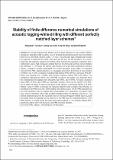Stability of finite difference numerical simulations of acoustic logging-while-drilling with different perfectly matched layer schemes
Author(s)
Tao, Guo; Wang, Hua; Shang, Xuefeng; Fang, Xinding; Burns, Daniel R
Download11770_2013_Article_400.pdf (1.285Mb)
PUBLISHER_POLICY
Publisher Policy
Article is made available in accordance with the publisher's policy and may be subject to US copyright law. Please refer to the publisher's site for terms of use.
Terms of use
Metadata
Show full item recordAbstract
In acoustic logging-while-drilling (ALWD) finite difference in time domain (FDTD) simulations, large drill collar occupies, most of the fluid-filled borehole and divides the borehole fluid into two thin fluid columns (radius ∼27 mm). Fine grids and large computational models are required to model the thin fluid region between the tool and the formation. As a result, small time step and more iterations are needed, which increases the cumulative numerical error. Furthermore, due to high impedance contrast between the drill collar and fluid in the borehole (the difference is >30 times), the stability and efficiency of the perfectly matched layer (PML) scheme is critical to simulate complicated wave modes accurately. In this paper, we compared four different PML implementations in a staggered grid finite difference in time domain (FDTD) in the ALWD simulation, including field-splitting PML (SPML), multiaxial PML(MPML), non-splitting PML (NPML), and complex frequency-shifted PML (CFS-PML). The comparison indicated that NPML and CFS-PML can absorb the guided wave reflection from the computational boundaries more efficiently than SPML and M-PML. For large simulation time, SPML, M-PML, and NPML are numerically unstable. However, the stability of M-PML can be improved further to some extent. Based on the analysis, we proposed that the CFS-PML method is used in FDTD to eliminate the numerical instability and to improve the efficiency of absorption in the PML layers for LWD modeling. The optimal values of CFS-PML parameters in the LWD simulation were investigated based on thousands of 3D simulations. For typical LWD cases, the best maximum value of the quadratic damping profile was obtained using one d[subscript 0]. The optimal parameter space for the maximum value of the linear frequency-shifted factor (α[subscript 0]) and the scaling factor (β[subscript 0]) depended on the thickness of the PML layer. For typical formations, if the PML thickness is 10 grid points, the global error can be reduced to <1% using the optimal PML parameters, and the error will decrease as the PML thickness increases.
Date issued
2014-03Department
Massachusetts Institute of Technology. Department of Earth, Atmospheric, and Planetary Sciences; Massachusetts Institute of Technology. Earth Resources LaboratoryJournal
Applied Geophysics
Publisher
Springer Berlin Heidelberg
Citation
Wang, Hua et al. “Stability of Finite Difference Numerical Simulations of Acoustic Logging-While-Drilling with Different Perfectly Matched Layer Schemes.” Applied Geophysics 10.4 (2013): 384–396.
Version: Author's final manuscript
ISSN
1672-7975
1993-0658